INTRODUCTION
Noxious weeds are widespread across Nevada, with 45 plant species legally designated as “noxious weeds” by the Nevada Department of Agriculture. Noxious weeds are species that are detrimental or destructive, and difficult to control or eradicate. In Nevada, noxious weeds are prohibited in commerce, and state law mandates their control or management. Landowners are responsible for controlling weeds on their property.
Paradise Valley is a large agricultural area in Humboldt County. The valley winters about 10,000 or more beef cows every year and produces grass hay and/or alfalfa hay on about 40,000 acres. This hay is used largely for local consumption, but some is exported to other cattle producing areas. The meadows, riparian areas, and brush fields in the valley provide habitat for many species of wildlife, including mule deer, pheasants, wild turkeys, ducks, geese, doves, shorebirds, small mammals, and several species of predators (e.g., mountain lion and bobcat). The agricultural fields and adjacent wildlands provide both year-long and seasonal habitat.
In addition to being an agricultural center, Paradise Valley is surrounded by public land administered by the Bureau of Land Management and the United States Forest Service. These lands have many valuable resources that support wildlife, recreation, livestock production, and other land uses. All of the public lands, but particularly the meadows and riparian areas, provide critical habitat for many wildlife species, including sage grouse, mule deer and pronghorn antelope. These lands are susceptible to invasion by at least one, and probably most of the noxious weed species that inhabit Paradise Valley.
Noxious weeds have been an issue in Paradise Valley since the 1940’s. The Paradise Valley Weed Control District (PVWCD) was formed in the 1940’s to address a noted increase in hoary cress (Cardaria draba) or short whitetop. Since creation of the Weed District, the scale of weed control efforts in the PVWCD has varied widely over time. Beginning in 2002, control efforts have expanded substantially for several reasons. These include the appointment of a permanent coordinator, the initiation of regular interaction with the University of Nevada Cooperative Extension and development of a comprehensive weed management plan. These developments occurred because hoary cress still is not under control, and numerous other weed species with significant ecological impact have become widespread. These species are Canada thistle (Cirsium arvense), leafy spurge (Euphorbia esula), mayweed chamomile (Anthemis cotula), musk thistle (Carduus nutans), medusahead (Taeniatherum caput-medusae), perennial pepperweed (Lepidium latifolium), poison hemlock (Conium maculatum), Russian knapweed (Acroptilon repens), saltcedar (Tamarix ramosissima), Scotch thistle (Onopordum acanthium), and water hemlock (Cicuta maculata). Each of these species covers an area from tens of acres to several thousand acres in and/or near the PVWCD.
The weed management plan developed by the PVWCD acknowledges the need to develop a large-scale focused treatment program to: 1) prevent the loss of additional acreage to noxious weeds and 2) prevent the establishment of additional noxious weed species in the district. Long-term success for weed control in the PVWCD, as well as all of Nevada, will require that all residents understand that noxious weeds can be effectively controlled. Control is defined as the reduction of weed populations to a manageable level with minimal subsequent economic impact and no or very few new infestations.
Many landowners are hesitant to spend money and/or time for chemical control of noxious weeds. They are unsure about the effectiveness of existing herbicides, many of which are expensive. Also, many individuals lack knowledge about when (i.e., timing) specific herbicide applications should occur, and/or the availability of new chemicals. Finally, treatment often does not occur because the window of opportunity for some species is short, and other time critical tasks are considered a higher priority.
Since 2003, the Humboldt County office of the University of Nevada Cooperative Extension, in cooperation with the PVWCD, has established a series of demonstration plots to increase local awareness and knowledge about the control of four noxious weed species: hoary cress (plots established 2003), leafy spurge (plots established 2003 and 2004), Russian knapweed (plot established fall 2004), and perennial pepperweed (plots established 2005). Each demonstration plot (or group of plots) was developed to address one or more of the following issues: 1) management of a weed the PVWCD had previously put little effort toward; 2) a recently released herbicide with no history of local use; and/or 3) an alternative time of year for treatment. This Special Publication addresses the fall application of Plateau® (Imazapic) on Russian knapweed. Other special publications (submitted) address the use of Plateau® on hoary cress, Plateau® and/or Tordon® (picloram) on leafy spurge, and treatment of perennial pepperweed with Plateau®, Cimarron®Max (metsulfuron and picloram), and a locally derived tank mix of the herbicides found in Cimarron®Max. The latter effort will be reported after post-treatment data are collected in 2006.
RUSSIAN KNAPWEED - THE TARGET SPECIES
Russian knapweed is a long-lived perennial broadleaf forb. New populations typically establish from seedlings. Long-term, its spread is largely from the lateral expansion of an extensive creeping root system. Individual plants reproduce vegetatively (i.e., are clonal) and become patches with many interconnected stems. These patches slowly have an increase in stem density and over time expand laterally. When multiple patches occur in an area, they slowly expand toward one another and eventually create a monoculture of Russian knapweed. The more valuable plants for forage and wildlife cover are lost.
The root system of individual Russian knapweed plants develops great depth and breadth. During the first year of growth, the primary root can reach a depth of over 8 feet if restrictive soil layers are absent. Roots can grow to over 23 feet deep by the end of the second growing season. Radial growth from lateral roots can reach 6.5 feet after two years, and cover a total area of about 130 square feet. Every inch of a root throughout the entire root system has one or more viable buds that can produce a new plant. Root segments as small as one inch long can produce new plants, and regrowth can occur from deeply buried buds, although the maximum burial depth is unknown.
The very extensive root system is supported by a comparatively small leaf area (<1 to several square feet per stem). The large amount of soluble carbohydrates (i.e., root energy reserves) in this extensive root system provides significant amounts of energy. This energy reserve allows plants to endure stress, and produce new stems and leaves following disturbance. As plants age, the increasing size of the root system (i.e., root length and diameter) and its large energy reserve makes herbicide control more difficult. Thus, the easiest weeds to control with chemicals are the youngest plants. Newly established plants or small clonal patches should be treated as they appear.
Russian knapweed may produce more than 1,200 seeds per rooted stem, per year. Some seed will remain viable for up to eight years, or longer. A relatively long period of seed viability will permit establishment of a persistent seed bank, capable of providing a source of new weeds long after the parent plants are eliminated. Effective, long-term control will require repeated follow-up control actions to eliminate recently germinated seedlings.
The typical treatment method used in Paradise Valley has been spring or fall application of Tordon® or RoundUp®. Tordon® has the limitation of being a restricted use herbicide. Applicators without a restricted use permit from the State Department of Agriculture cannot legally apply Tordon®. Also, Tordon® is both persistent and mobile in the soil, which may render it an undesired herbicide for some situations. RoundUp® is a non-selective herbicide that can easily kill nontarget, but highly desired species. Its use is largely restricted to non-crop industrial sites and/or alfalfa stands undergoing renovation.
This Special Publication reports the results of Plateau® applied to a mature stand of Russian knapweed in late October 2004. Plateau® is a selective (broadleaf species and annual grasses) and persistent herbicide, with somewhat less soil mobility than Tordon®. Unlike Tordon®, the applicator of Plateau® does not have to be certified to apply restricted use herbicides. If Plateau® can successfully control Russian knapweed, it can be used by landowners/managers who lack certification to apply restricted-use herbicides. Also, it may be useful in situations where Tordon® or RoundUp® are less appropriate products.
METHODS
A one-acre non-replicated treatment site was selected on the south side of Shelton Lane, at the “S-curve”, approximately 40 miles north of Winnemucca. The treatment area is on the floodplain of Cottonwood Creek and has very deep silty soil that is poorly drained, and mildly to strongly alkaline. The clay content in the soil’s upper 3 feet is typically between 30 and 45 percent. A seasonally high water table can reach the soil surface during early spring, but declines during the summer and fall to 5 to 10 feet deep, or deeper. The deep soil and relatively shallow water table allow the deep roots of Russian knapweed to access water throughout the growing season, and remain photosynthetically active. This site may receive supplemental irrigation water when the snowpack is sufficient. It was not irrigated for at least 3 years prior to treatment, but received irrigation for at least 2 to 4 weeks in the spring of 2005, the first growing season after treatment. The treated area had a mix of small and large patches of Russian knapweed. Hoary cress was also widespread across the plot. Scattered plants of Great Basin wildrye (Leymus cinereus) were present, and some areas in the treatment plot had a residual component of rhizomatous wheatgrasses and grass-like (wiregrass and sedge) plants. Other spots had no desirable species.
Plateau® was mixed with two pints of methylated seed oil (MSO) and applied on October 25, 2004, well after the first frost.. The Plateau® was applied at the maximum labeled rate of 3 oz. active ingredient (Imazapic) per acre (12 oz. of product/acre). A tractor mounted boom sprayer was used, with the boom mounted about 30 inches above the ground (Figure 1a). Methlyated seed oil is used instead of traditional surfactants because research indicates MSO results in better deposition and uptake of Plateau®.
Light snow fell the morning of application, but the temperature at the time of application was near 45°F. There was complete cloud cover and some wind. Most Russian knapweed plants were very desiccated and were not actively growing (Figure 1b). Most, if not all herbicide activity was from movement of the active ingredient into the soil and through the root system. Knapweed patches that were small or had less foliar cover (live or dead) received a substantial amount of the herbicide directly on the ground surface immediately above the root systems (Figure 1c). The large patches with ground cover close to 100% had all or nearly all of the herbicide intercepted by dead stem material. (Figure1b). These microsites often had multiple layers of stems, which probably reduced the amount of herbicide moved from the leaves to the soil during precipitation events.
The treated area was photographed at the time of treatment to document the extent of the Russian knapweed invasion. Repeat photography of the same locations was collected on June 28, 2005. Russian knapweed in adjacent untreated areas was typically between 6 and 15 inches tall on June 28, 2005.
RESULTS
Figures 2a, 3a, 4a, and 5a show different patches of Russian knapweed at the time of treatment with Plateau®. Paired photos were obtained on June 28, 2005 (Figures 2b, 3b, 4b, 5b and 5c). All knapweed patches had a substantial reduction in the density and canopy cover of Russian knapweed. Visual observation indicates an average decline in Russian knapweed of 75 to 85%. Larger patches of knapweed appear to have declined slightly less than the smaller and presumably younger patches.
Plateau® had no apparent adverse effect on desired perennial grasses (Figures 3b, 5b-c). All sizes of Great Basin wildrye plants were widely scattered across the plot in June 2005, and all had vigorous growth. Also, several species of rhizomatous wheatgrass and other wildryes were widespread in some areas of the plot after treatment. They appeared most abundant on depressed microsites with better soil moisture content longer into the growing season. Also, an unknown herbaceous sagebrush (Artemisia sp.) species had excellent regrowth.
A secondary benefit of this application was the nearly complete control of hoary cress. This noxious weed was widespread in the fall of 2004 (Figure 1c), and virtually absent in June 2005. The effects of Plateau® on hoary cress will be discussed in a later UNCE Special Publication.
The application of Plateau® also left large areas of bare ground (Figures 2b, 4b, 5c). The corresponding before-treatment photos indicated these sites largely lacked perennial vegetation (i.e., knapweed or grasses), and were mostly inhabited with annual weeds.
DISCUSSION
The Plateau® treatment was slightly less effective on the large knapweed patches with nearly 100% canopy cover. These sites showed substantial reductions in Russian knapweed but not as much as small patches or in large knapweed patches with canopy cover (from Russian knapweed) well under 90-100%. Several reasons may account for this pattern of response. First, after the initial establishment of Russian knapweed, it spreads vegetatively from a creeping root system. Large patches, especially those with very high canopy cover, indicate old patches with extensive root systems. Root systems in large old patches have more total biomass and a greater spatial extent, both vertically (depth) and laterally, compared to small young patches. Greater biomass distributed over a larger area requires that the active ingredient in an applied herbicide affect more living tissue further from the point of uptake to be effective. In large patches, the same amount of herbicide applied per unit area must move a greater distance through the plant to kill all living tissue. The ultimate effect is the same amount of herbicide will usually be less effective on large root systems than small root systems; thus, the lower control rate observed in the large patches.
Figure 1a. Application of Plateau® with a tractor mounted boom sprayer, located about 30 inches above the ground.
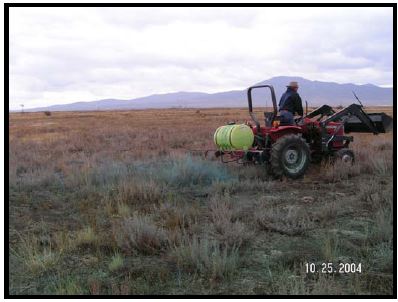
Figure1b. Dense stands of Russian knapweed had high amounts of cover from dead and desiccated leaves and stems. Very little of the applied herbicide penetrated these canopies and was placed on the surface of the soil.
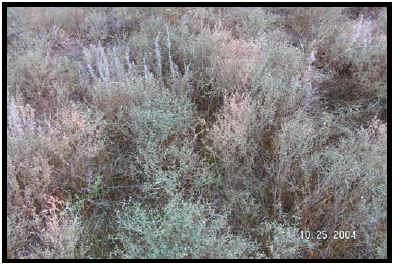
Figure 1c. Open areas in and adjacent to knapweed patches had substantial amounts of Plateau® placed on the soil surface and on the leaves of isolated weeds.
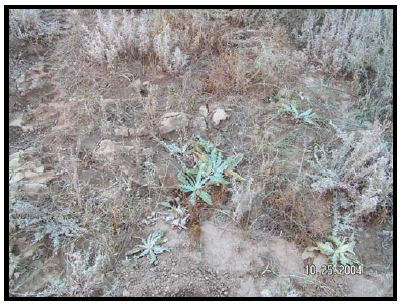
Figure 2a. The western boundary of the treatment plot when Plateau® was applied on October 25, 2004. The two areas outlined are patches of Russian knapweed.
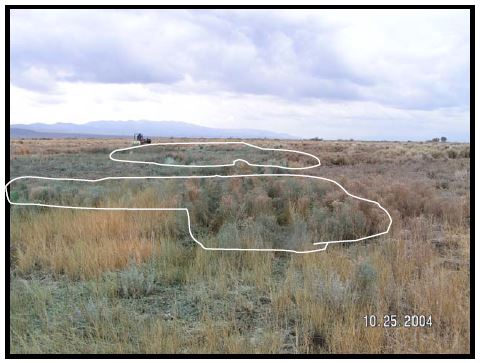
Figure 2b. The same area shown in figure 2a, but on June 28, 2005, the first spring after treatment with Plateau®. The two knapweed patches outlined in Figure 2a are absent. Also, there has been excellent short-term control of hoary cress, the short plant in the untreated area.
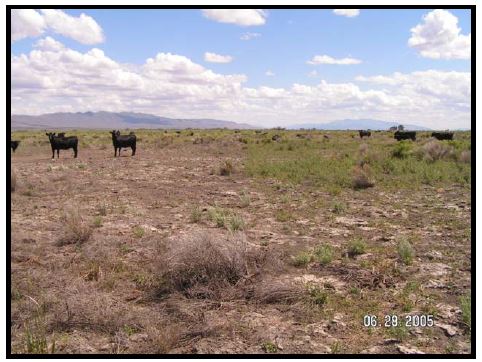
Figure 3a. The northwest corner of the treatment plot when Plateau® was applied, on October 25, 2004. The outlines identify patches of Russian knapweed. The arrow shows a reference point in both Figures 3a and 3b.
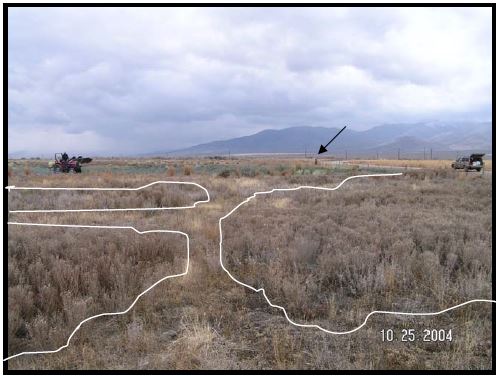
Figure 3b. The same area shown in Figure 3a, but on June 28, 2005, the first spring after treatment. The taller plants in Figure 3b are mostly an herbaceous sage. Both dense knapweed patches outlined in Figure 3a are much reduced, but scattered plants of Russian knapweed still exist. There has been good initial recovery of desired perennial grasses.
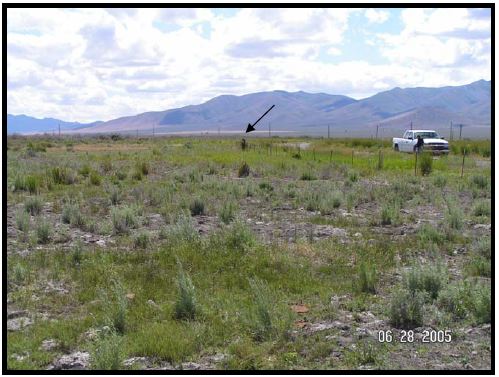
Figure 4a. The southwest corner of the treatment plot when Plateau® was applied on October 25, 2004. The polygons identify patches of Russian knapweed. The arrow provides a reference point for figures 4a and 4b.
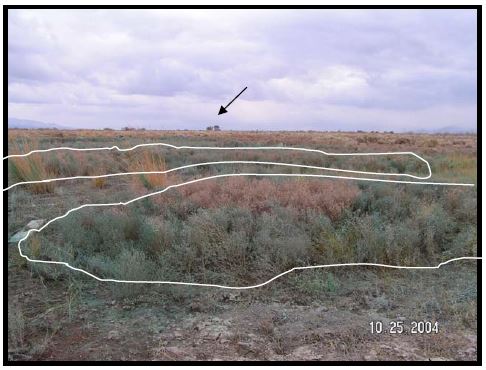
Figure 4b. The same area shown in Figure 4a on June 28, 2005. The large knapweed patches outlined in Figure 4a are largely absent. Most of the tall species in Figure 4b are an herbaceous sagebrush species that was released following application of Plateau®.
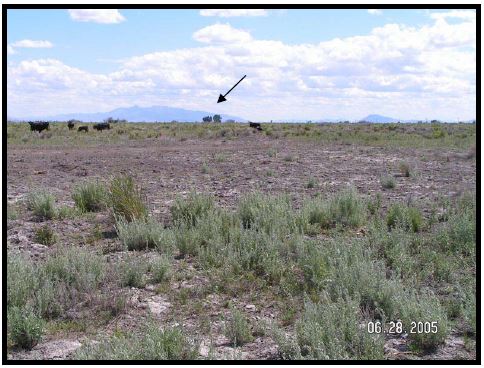
Figure 5a. The southeast section of the treatment plot when Plateau® was applied on October 25, 2004. The polygon in Figure 5a outlines a patch of Russian knapweed. The arrows and letter “a” in Figures 5a-c identify respective reference points in each photo.
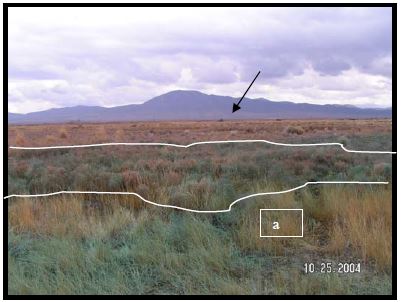
Figures 5b and 5c. The area shown in Figure 5a on June 28, 2005. The canopy cover of the patch of Russian knapweed has been greatly reduced. A visual estimate of the short-term control of Russian knapweed was about 80%, with treated plants being smaller than in adjacent untreated areas. The pasture grasses have had excellent survival and regrowth the spring after application of Plateau®.
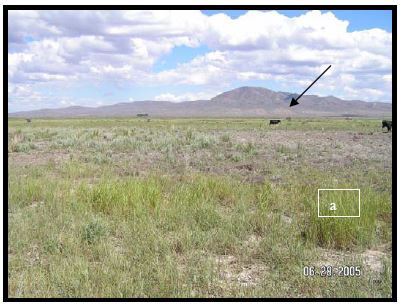
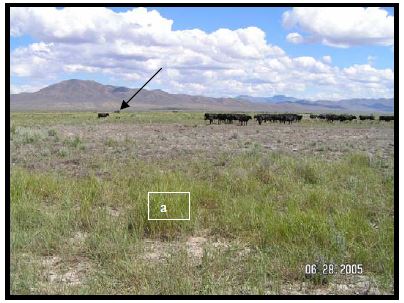
Second, smaller and/or younger knapweed patches often have less canopy cover of both recent and old (>1 year) stems and leaves. Less total plant cover (i.e., live and dead) above the ground should allow more Plateau® to reach the ground surface. This is important because leaf uptake in the late fall from desiccated plants should be lower than earlier in the season when the entire canopy is photosynthetically active (growing).
Fall and winter precipitation in 2004 was above average and allowed the Plateau®, a chemical with relatively high soil mobility, to move into the root zone were uptake could occur from late fall through early spring. About one-half of the Plateau® applied to the soil is usually active after 4 months (i.e., the soil halflife is about 4 months). This half-life is longer than for most herbicides, and probably is longer than 4 months when Plateau® is applied in the fall. The primary cause of degradation of Plateau® is decomposition from soil microbes. Microbial decomposition in the late fall and early winter is virtually absent because soil temperatures are too cold and/or soil moisture is too low. Microbial decomposition is highest in warm and moist conditions. Knapweed patches with high canopy cover, particularly when there are layers of live and dead material, probably have more herbicide intercepted by the desiccated leaves and stems, with substantially less reaching the soil surface. Less Plateau® on the soil surface at or shortly after application would reduce the control of Russian knapweed (and other species), because the herbicide is degraded by sunlight (photodegradation), is transported off-site by water or wind (dessicated stems break at ground level and are blown down-wind), or is consumed by herbivores and degraded by the microbes in their digestive system.
Another possible reason for reduced control on large knapweed patches is the distance from bare ground at the edge of the patch to the older plants located at the center of the patch. For small patches, compared to large patches, any herbicide placed on bare ground adjacent to the patch has less distance (i.e. root length) to travel to reach the oldest plants at the center of the patch. The biomass that must be affected, and the distance the chemical must travel to reach the furthest roots from the points of uptake, are less than for large patches. In other words, the same amount of herbicide applied on bare ground at the edge of a small patch has less biomass to act upon than for a large patch.
The substantial control of Russian knapweed with Plateau® when the target plants were very desiccated indicates Plateau® probably provides a wide window (time-frame) of opportunity for application in Paradise Valley. Similar results could be expected in areas with similar soil, climate, and plant growth patterns. A wide window of opportunity provides producers important flexibility in their weed control programs. The timing of many weed control programs coincides with other management or production activities that cannot be delayed. The longer the period during which weeds can be effectively treated the more likely producers (and other entities) will develop successful weed treatment programs.
This project also underscores the importance of post-treatment grazing management. The treated area was in a depleted grass pasture that had not been irrigated for at least four years due to drought. The grasses had been grazed each year and were undergoing increasing competition from Russian knapweed and hoary cress. Stress from the drought and the noxious weeds was largely eliminated or greatly reduced in the spring of 2005, but the desired grasses were exposed to season-long grazing (early May into mid-July or later). Repeated defoliation of the palatable rhizomatous grasses undoubtedly reduced their ability to spread from their existing locations to adjacent locations that were mostly bare ground. Furthermore, seed production was obviously reduced, compared to nearby ungrazed meadows that were not cut until after seed-set. Desired pasture grasses that are weakened from drought and competition from weeds need a recovery period so they can increase in size (i.e., become more competitive) and expand into areas previously occupied by the treated weeds. Without proper posttreatment grazing management, the target weed species will quickly return and fully reoccupy the site. Also, treated sites are susceptible to infestation by other noxious weeds equally as undesirable as Russian knapweed. Intensive and focused post-treatment management for both grazing and re-establishment of pasture grasses must occur.
Any application of Plateau® should consider possible effects on water quality, and down gradient use of the water. Plateau® is relatively mobile and being persistent in the soil could have adverse effects on down gradient crops and vegetation, under certain circumstances. All applicators should read the product label and become familiar with characteristics of Plateau® and the specific characteristics of their weed situation.
CONCLUSIONS
- The application of Plateau® herbicide in late October provided good control of Russian knapweed on deep soils in Paradise Valley.
- Follow-up treatments are necessary to control remnant plants.
- There was excellent control of hoary cress rosettes located on the treatment plot.
- Great Basin wildrye and rhizomatous wheatgrasses were not adversely affected by Plateau® at the maximum labeled rate, and responded well following competitive release.
- Sites with substantial bare ground after treatment must be quickly revegetated.
- Post-treatment management must include proper grazing management to ensure the spread of desired grasses into areas left bare by the control of Russian knapweed.
BIBLIOGRAPHY
BASF Corporation. Plateau® specimen label. Available at CDMS.
Duncan, C.A. 2005. Russian knapweed. Acroptilon repens (L.) DC. Pp. 8-15. In: Celestine L. Duncan, and Janet K. Clark (eds). Invasive Plants of Range and Wildlands and their Environmental, Economic, and Societal Impacts. Weed Science Society of America. Lawrence, Kansas. 222 pp.
EXTOXNET. 2005. Picloram (Tordon®).
Paradise Valley Weed Control District. 2003. Weed free by twenty three. A plan to combat the spread of noxious weeds within the confines of Paradise Valley, Nevada. 29 pp + appendices.
Roche, B.F., and C.T. Roche. 1991. Identification, distribution, ecology, and economics of Centaurea species. Pp. 274- 291. In: LF. James, J. Evans, M. Ralphs, and R. Child (eds). Noxious Range Weeds. Westview Press. Boulder, CO. 466 pp.
United States Department of Agriculture, Natural Resources Conservation Service. 2002. Soil survey of Humboldt County Nevada, east part.
Vencill, W.K. (ed). 2002. Herbicide handbook. Eighth Edition. Weed Science Society of America. Lawrence, Kansas. 493 pp.
Whitson, T.D. 1999. Russian knapweed. Pp. 315-322. In. Roger L. Sheley and Janet K. Petroff (eds). Biology and management of noxious rangeland weeds. Oregon State University Press. Corvallis, Oregon. 438 pp.


